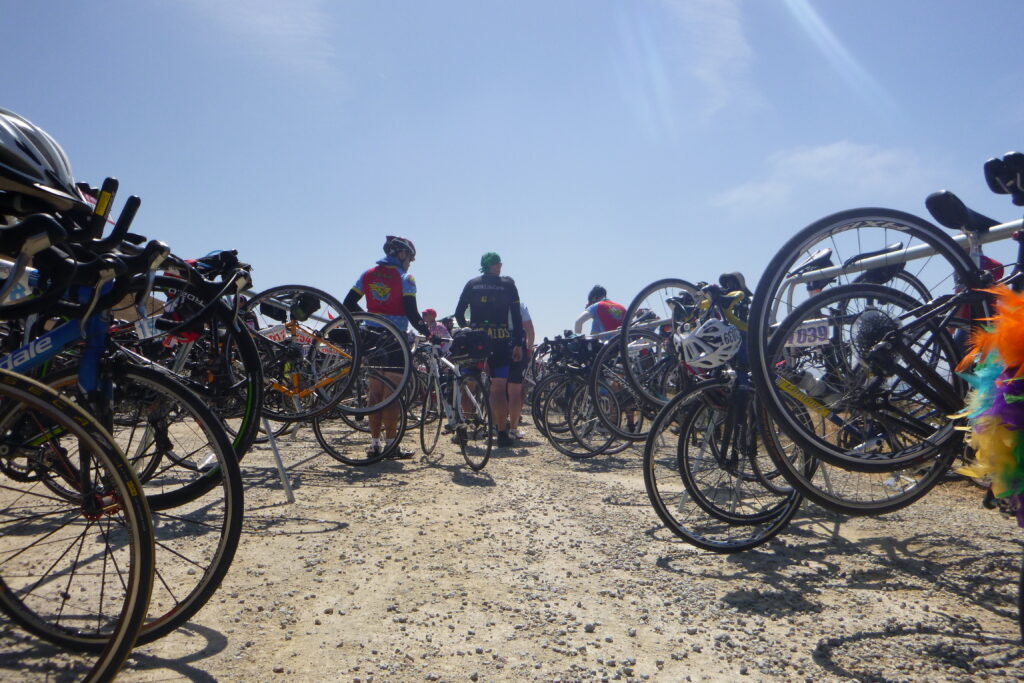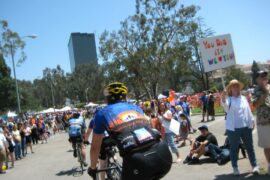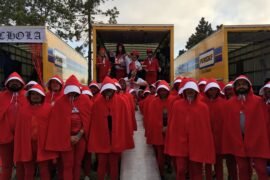For you newbies, here’s a little background. The AIDS/LifeCycle is a fund-raising, 545 mile, 7 day bicycling journey from San Francisco to Los Angeles that takes place the first week of June each year. The ride began in 1994 as The California AIDS Ride and was eventually taken over by the AIDS/LifeCycle. It has been called the mother of all supported rides with good reason. Aside from being possibly the most well organized, supported and flat out fun charity cycling event ever, coming at the height of a global pandemic, it was also a way to raise desperately needed funds, (over $100 million dollars so far) for prevention and care while raising public awareness along the route. And you can do it all while sporting a red feather boa. More on that later…
At Upshift Cycles, we take the tradition of a Local Bike Shop seriously and we are proud to support the AIDS/LifeCycle, which is coming at us fast in the first week of June. This blog is being created to impart wisdom and to answer whatever questions you may have about this amazing journey of heart and clipless pedals. Many members of the Upshift family have participated, and the author of this blog has completed the ride 19 times so far. Sadly, 2025 will be the last year that this event will be held. We at Upshift Cycles are a great resource for outfitting and information to prepare you for this utterly amazing event, so post your questions below and we will do our best to answer.
I. You signed up! You are now halfway to the Halfway to LA Point!
Congratulations! OK. Now what? Getting a bike is a great way to get this going, but what kind of bike will I need, you ask? Contrary to popular belief, a Grand Tour ready race rocket is not a requirement. I did my first two rides on a basic Cannondale H300 Hybrid, then switched to a Specialized Hardrock hardtail mountain bike, which I outfitted with slicker tires, and then moved on to a Specialized Sirrus flat bar road bike. My last four rides were done on a Bianchi Intenso endurance road bike customized with a flat bar. Many riders, including the previous owner of our shop, have done the ride on tandems and/or fixies. What’s important is having a bike with all its components in good working order. Starting a ride like this with a worn out drive train or iffy brakes is not gonna end well.
If you do not already have a bike that you want to use on the ride, make sure that the sales folk at the shop of your choice, like Upshift (hint, hint) know what you will be doing and can guide you properly. Think in terms of how you want to use the bike after the ride as well. Do you want to get into racing or triathlons? A full on road bike like a Bianchi Sprint would be a great choice. Looking to do more casual distance riding or begin commuting or bike packing maybe? A modern day, versatile gravel bike like the Specialized Diverge with a road-friendly drive train set-up may be the thing.
If there is one thing to keep in mind, it is comfort. You are going to be spending some crazy long hours in that saddle training and while on the event. Here are some essential questions you should think about and go from there:
– Drop bar or flat bar?
– Road or gravel style?
– Race geometry or endurance?
– What size bike do I ride anyway?
Bicycles with race geometry will put you in a more aggressive position than an endurance frame, with a shorter wheelbase, longer reach between saddle and handlebar, and lower position of the cockpit. Handling tends to be fast and responsive to the point that many find them “twitchy.” Endurance geometry will feature a longer wheelbase, a more slack angle on the front fork and a higher cockpit that can offer a slightly more relaxed and upright position. This can result in more comfort for a long ride along with more stable handling. By the way, there are plenty of endurance frames that are more than suitable for racing, like the Specialized Roubaix and the Bianchi Infinito.
Speaking of size, your best friend may have a really nice bike that they are willing to part with, but if you are different heights or even similar height but are very different in leg length and torso proportions it may not be ideal. We can help you determine which size is going to work best for you.
Once you have chosen a bike, the next question you may ask is “where do I put my feet on this thing?” Our next installment will dive headfirst into the wacky (and frequently contentious) debate over the right and perfect pedal type. Watch this space…
Let us know if you have questions in the comments below!






3 Comments
I’m a new rider. I’m determined to do this ride in 2025. Thoughts on the Poseidon X Ambition dropbar vs a road bike? Retrospect has a culver road bike for $400 but it is 35 lbs. I’m new to long distance, larger, I like to go fast but be in control, I have no credit card and limited funds. The bike programs listed on the website are not emailing me back. 5’11, 31 inseem, 235 lbs, powerful legs. I fear popping a tire, ruining a crank, or having to walk it uphill. I live on the Oregon coast with more fat tire rentals than road bikes.
Thank you for any advice.
Georgia
Hi Georgia! The great thing about most gravel bikes is they are also pretty good road bikes. And there really are no rules on what kind of bike to ride. I have ridden to LA on a hardtail mountain bike, a hybrid and a flat bar road bike. You will even see fixies out there. WIth the right tires, a gravel bike like the Poseidon will be great out there. It will offer you a more relaxed riding position and a good range of gears for hammering along the flats or climbing hills with the advantage of only dealing with one shifter. One very slight disadvantage is that the wide range of gears on the cassette with a one-by up front will tend to have bigger jumps between shifts, meaning it may not be as easy to find your Goldilocks gear for small terrain changes, but you will get used to it. I am not a big fan of mechanical disc brakes, but overall the bike you described should be fine. There are also lots of good choices for entry level gravel bikes, like the Specialized Diverge that we carry. Make sure your local bike shop knows you are planning to take the bike on this journey and they can really help to guide you. See you out there!
Hi again. Having flats is a part of cycling. The good news is that changing a tube is pretty easy once you know how, and there is lots of support on the road to help if you need it. Having good tires and always maintaining proper tire pressure goes a long way towards prevention as well. I check and top off my tires every morning before riding out of camp on the way to LA. And don’t worry if you can’t make it up every hill. Lots of people cross train by walking up them a bit. The hills on this ride are mostly gentle, but there are some short nasty ones thrown in for fun. Good training in the months before the ride will teach you how to use your gears to let your bike do its magic on a climb. You will be surprised…